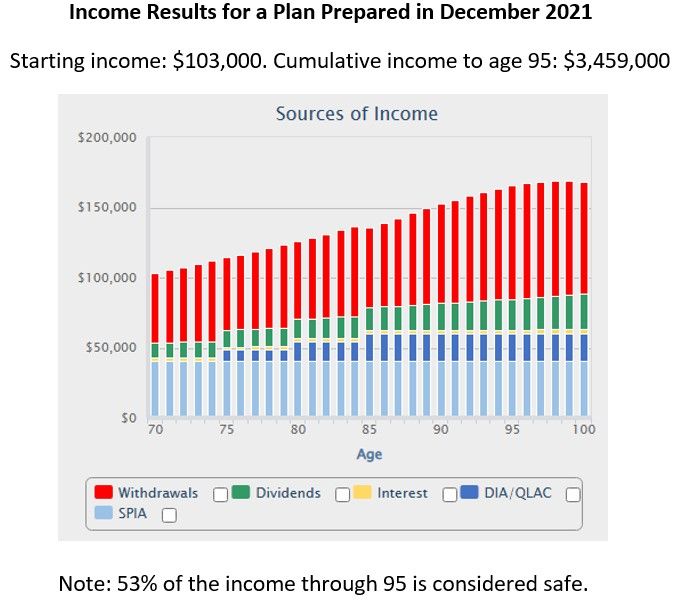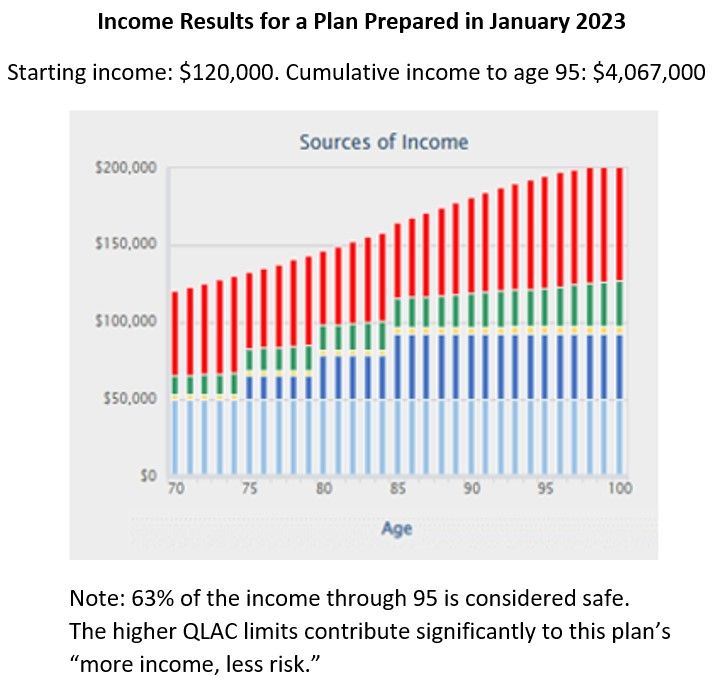Curious About a QLAC? SECURE 2.0 Act Gives This Annuity a Boost
New legislation raises the amount you can transfer from your rollover IRA to a qualifying longevity annuity contract (QLAC), reducing RMDs and increasing guaranteed lifetime income.
- (opens in new tab)
- (opens in new tab)
- (opens in new tab)
- Newsletter sign up Newsletter


The SECURE 2.0 Act of 2022, enacted at the end of December, contains provisions that make it much easier to purchase a pension-like annuity called a QLAC for your retirement income plan. The new legislation allows you to defer more taxes and buy more retirement income from your 401(k), rollover IRA or similar tax-qualified accounts. The maximum QLAC per individual is now $200,000 with no percentage-of-savings limit.
Combine this with the higher annuity payouts due to higher interest rates from these vehicles, and we’re talking about 100% to 250% more income from this source when compared to December 2021. Importantly, QLACs, or qualifying longevity annuity contracts, are offered only by some of the highest-rated insurance companies in the U.S.
What Is a QLAC and How Does It Work?
A QLAC is technically a deferred income annuity purchased by a tax-free transfer of a portion of your tax-qualified accounts generally made after age 55. That transfer, in addition to adding a QLAC to your plan, represents a reduction in your account for the purposes of determining taxable required minimum distributions, or RMDs. So, if you used 25% of a $400,000 qualified account, your $100,000 purchase of a QLAC would reduce your RMDs by 25%. And the income from a QLAC could be deferred until as late as age 85. (For more information, see New RMD Rules: Starting Age, Penalties, Roth 401(k)s, and More in SECURE 2.0.)

Sign up for Kiplinger’s Free E-Newsletters
Profit and prosper with the best of expert advice on investing, taxes, retirement, personal finance and more - straight to your e-mail.
Profit and prosper with the best of expert advice - straight to your e-mail.
While tax deferral to age 85 is nice and has a real economic value, it is also important to think about how you can use the income benefits of that $100,000 investment to improve your retirement. Let me give you two examples:
- A couple, both age 65 with a retirement income plan that’s in good shape, wants to ensure they can pay premiums on their long-term care and life insurance late in retirement. They can use the $100,000 to purchase lifetime income starting at age 85 of $36,000 per year — guaranteed. More than enough to pay the premiums.
- If you’re single but your retirement income plan is a little shaky after the financial upsets of 2022, and you’re concerned about inflation, you can use the QLAC to ladder guaranteed income that starts at age 75 and continues to grow. More about that in the example below.
Background on the SECURE 2.0 Act
Most of the news reporting about SECURE 2.0 has focused on the other parts of the legislation that make it easier for part-time employees and employers to create savings plans, along with an extension to age 73 at which age RMDs must be claimed. It also permits unused 529 accounts to be applied to a Roth account. For an overview of what’s in the legislation, see SECURE 2.0 Act Changes 401(k), IRA, Roth, and Other Retirement Plan Rules.
At the same time, many retirement advisers have been caught unaware of the QLAC provisions. (I’m being generous. Your adviser may not talk about a QLAC or income annuities generally because they don’t have the planning software to provide guidance to customers.)
Rules in the 2019 legislation that created the original SECURE Act (stands for Setting Every Community Up for Retirement Enhancement) limited the tax-deferred investments into a QLAC to $125,000, (with adjustments for inflation) or 25% of the account if lower. As mentioned above, the new rules allow up to $200,000 of tax-benefitted savings toward a QLAC, and the percentage-of-savings requirement has been removed.
Another benefit is included in the SECURE 2.0 Act: You can now include a “return of premium” feature in your QLAC so that the purchase amount, less any payouts, goes to a beneficiary at your passing.
What the Higher QLAC Limits Could Mean to You
QLAC investors at the legislative maximum get two simultaneous tax benefits: $200,000 is excluded from the RMD test, and the QLAC income can be deferred to later in retirement. Together with income from the balance of qualified savings and Social Security, the retiree can more easily meet income needs for life, while creating liquidity for other needs late in retirement.
To demonstrate, if in December 2021 a male aged 70 used $135,000 (the 2021 maximum) to purchase a QLAC, it would have paid income of $38,000 at age 85. Now, just a little more than a year later, you could purchase income of $75,000 a year. That’s because of the increase in the QLAC maximum to $200,000 a year combined with the higher interest-rate-based payout. (You can get a personalized quote (opens in new tab) that shows how a QLAC could work for you.)
For that same 70-year-old male, the examples below show similar improvement with a Go2Income Plan for Retirement Income that utilizes dividends, interest payments, IRA withdrawals and annuity payments. (For more information, see For Sustainable Retirement Income, You Need These 5 Building Blocks.)


Another View of QLAC
Mark Iwry is a former Treasury Department official who helped create QLAC during the Obama administration, and he also consulted on the expansion of QLAC provisions in SECURE 2.0. He told the Retirement Income Journal (opens in new tab) that QLACs can especially benefit women, who are the most likely to live into their 90s.
“The combination of mortality pooling and predictable investment for 15 to 20 years produces a meaningful add-on to Social Security income starting at 80 or 85,” Iwry told the online journal. “Never mind that Homer (Simpson) thinks all those beers and cheeseburgers mean he’ll never live past 80. The QLAC is for Marge.”
Whether you’re male, female or a couple, a QLAC is a financial instrument that should be considered.
For a specific look at the changes a QLAC could make in your own retirement, visit Go2Income (opens in new tab) for a complimentary Plan for Retirement Income. This funny-sounding idea that was just expanded through legislation is something you should consider.
This article was written by and presents the views of our contributing adviser, not the Kiplinger editorial staff. You can check adviser records with the SEC (opens in new tab) or with FINRA (opens in new tab).

Jerry Golden is the founder and CEO of Golden Retirement Advisors Inc. (opens in new tab) He specializes in helping consumers create retirement plans that provide income that cannot be outlived. Find out more at Go2income.com (opens in new tab), where consumers can explore all types of income annuity options, anonymously and at no cost.
-
-
 For Best Tax Savings, Year-Round Tax Planning Is Essential
For Best Tax Savings, Year-Round Tax Planning Is EssentialFor optimal, ongoing tax reduction, consider employing these nine strategies throughout the entire year.
By Andy Leung, Private Wealth Adviser • Published
-
 From SECURE Act to SECURE 2.0: Is Your Estate Plan Safe?
From SECURE Act to SECURE 2.0: Is Your Estate Plan Safe?The ever-evolving legislative landscape provides both challenges and opportunities when it comes to making plans for your retirement and your estate. A key focus: tax planning.
By Lindsay N. Graves, Esq. • Published
-
 For Best Tax Savings, Year-Round Tax Planning Is Essential
For Best Tax Savings, Year-Round Tax Planning Is EssentialFor optimal, ongoing tax reduction, consider employing these nine strategies throughout the entire year.
By Andy Leung, Private Wealth Adviser • Published
-
 From SECURE Act to SECURE 2.0: Is Your Estate Plan Safe?
From SECURE Act to SECURE 2.0: Is Your Estate Plan Safe?The ever-evolving legislative landscape provides both challenges and opportunities when it comes to making plans for your retirement and your estate. A key focus: tax planning.
By Lindsay N. Graves, Esq. • Published
-
 Is Inflation a Big Retirement Worry? How to Protect Savings
Is Inflation a Big Retirement Worry? How to Protect SavingsConcerns about how inflation eats into your resources or limits your ability to save sufficiently for retirement are real, but there are four things you can do to cope.
By Jason “JB” Beckett • Published
-
 Short-Term Financial Planning for First-Time Parents
Short-Term Financial Planning for First-Time ParentsA seasoned wealth adviser shares his experience with the financial planning he and his wife did for the arrival of their first bundle of joy.
By Kara Duckworth, CFP®, CDFA® • Published
-
 Longevity: The Retirement Problem No One Is Discussing
Longevity: The Retirement Problem No One Is DiscussingMany people saving for retirement fail to take into account how living longer will affect how much they’ll need once they stop working. What should they do?
By Brian Skrobonja, Chartered Financial Consultant (ChFC®) • Published
-
 Capital Gains Taxes Trap: How to Avoid Mutual Fund Tax Bombs
Capital Gains Taxes Trap: How to Avoid Mutual Fund Tax BombsIt’s bad enough when your mutual fund’s assets lose value, but owing unexpected capital gains taxes after those losses is doubly frustrating.
By Samuel V. Gaeta, CFP® • Published
-
 Why Investors Should Avoid Buying the Banking Sector Dip
Why Investors Should Avoid Buying the Banking Sector DipEven though things appear to have settled after SVB's collapse, that doesn’t mean all is clear. Consider options like healthcare and consumer staples instead.
By Austin Graff, CFA • Published
-
 Four Sustainable Investments That Could Have a Positive Impact
Four Sustainable Investments That Could Have a Positive ImpactAs we celebrate Earth Day, consider doing some research aimed at transitioning to a more sustainable and responsible portfolio. These four companies are worth a look.
By Peter Krull, CSRIC® • Published







